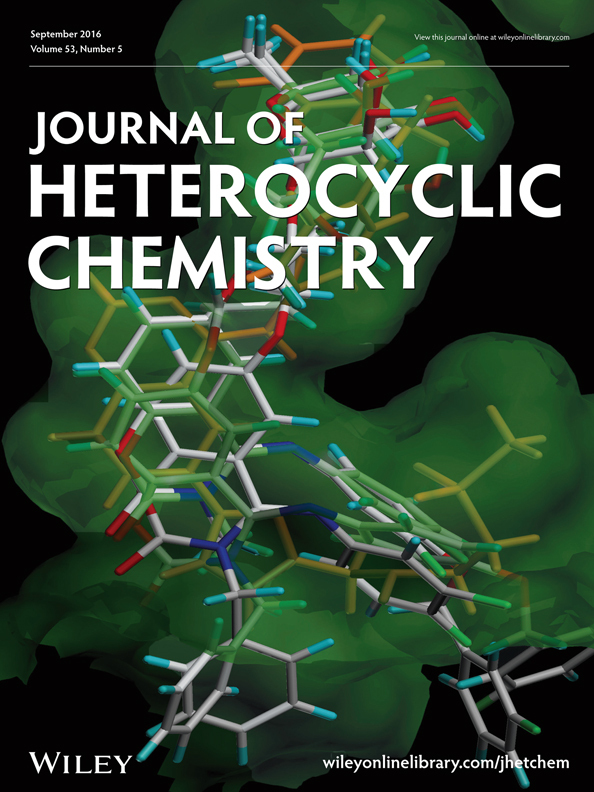Highly Efficient Cycloaddition Reaction of 1,3-Diynes with Sodium Azide: A New Way to 5-Substituted-4-acetylene-1H-1,2,3-triazoles
Jia-Liang Tang
Department of Chemistry, State Key Laboratory of Pollution Control and Resource Reuse, Tongji University, Shanghai, 200092 People's Republic of China
Search for more papers by this authorLing Ming
Department of Chemistry, State Key Laboratory of Pollution Control and Resource Reuse, Tongji University, Shanghai, 200092 People's Republic of China
Search for more papers by this authorCorresponding Author
Xiao-Ming Zhao
Department of Chemistry, State Key Laboratory of Pollution Control and Resource Reuse, Tongji University, Shanghai, 200092 People's Republic of China
E-mail: [email protected]Search for more papers by this authorJia-Liang Tang
Department of Chemistry, State Key Laboratory of Pollution Control and Resource Reuse, Tongji University, Shanghai, 200092 People's Republic of China
Search for more papers by this authorLing Ming
Department of Chemistry, State Key Laboratory of Pollution Control and Resource Reuse, Tongji University, Shanghai, 200092 People's Republic of China
Search for more papers by this authorCorresponding Author
Xiao-Ming Zhao
Department of Chemistry, State Key Laboratory of Pollution Control and Resource Reuse, Tongji University, Shanghai, 200092 People's Republic of China
E-mail: [email protected]Search for more papers by this authorAbstract
A cycloaddition reaction of a range of 1,3-diynes with sodium azide has been realized, which provided 5-substituted-4-acetylene-1H-1,2,3-triazoles in 75–99% yields. The chemical structures of the new compounds 3 are established by IR, NMR, Mass, and HRMS.
Supporting Information
| Filename | Description |
|---|---|
| jhet1950-sup-0001-supplementary_material.docWord document, 1.5 MB | Supporting info item |
Please note: The publisher is not responsible for the content or functionality of any supporting information supplied by the authors. Any queries (other than missing content) should be directed to the corresponding author for the article.
References and Notes
- 1(a) Amblard, F.; Cho, J. H.; Schinazi, R. F. Chem Rev 2009, 109, 4207;
(b) Meldal, M.; Tornøe, C. W. Chem Rev 2008, 108, 2952;
(c) Kolb, H. C.; Finn, M. G.; Sharpless, K. B. Angew Chem Int Ed 2001, 40, 2004.
10.1002/1521-3773(20010601)40:11<2004::AID-ANIE2004>3.0.CO;2-5 CAS PubMed Web of Science® Google Scholar
- 2(a) Kolb, H. C.; Sharpless, K. B. Drug Discov Today 2003, 8, 1128; (b) Astruc, D.; Liang, L. Y.; Rapakoushiou, A.; Ruiz, J. Acc Chem Res 2012, 45, 630; (c) Lutz, J. F. Angew Chem Int Ed 2007, 46, 1018; (d) Felix, A. M.; Merrifield, R. B. J Am Chem Soc 1970, 92, 1385.
- 3Sharpless, K. B.; Fokin, V. V.; Green, L. G.; Rostovtsev, V. V. Angew Chem Int Ed 2002, 114, 2708.
10.1002/1521-3757(20020617)114:12<2126::AID-ANGE2126>3.0.CO;2-6 Google Scholar
- 4(a) Meldal, M.; Tornoe, C. W. Chem Rev 2008, 108, 2952; (b) Ozcubukcu, S.; Ozkal, E.; Jimeno, C.; Pericas, M. A. Org Lett 2009, 11, 4680.
- 5(a) Monkowius, U.; Ritter, S.; Konig, B.; Zabel, M.; Yersin, H. Eur J Inorg Chem 2007, 4597; (b) Luu, T.; Mcdonald, R.; Tykwinski, R. R. Org Lett 2006, 8, 6035; (c) Doak, B. C.; Scanlon, M. J.; Simpson, J. S. Org Lett 2011, 13, 537; (d) Aizpurua, J. M.; Azcune, I.; Fratila, R. M.; Balentova, E.; Aizpurua, M. S.; Miranda, J. I. Org Lett 2010, 12, 1584.
- 6(a) Chen, Y. Z.; Wu, M. J. Org Lett 2005, 7, 475; (b) Mandadapu, A. K.; Sharma, S. K.; Gupta, S.; Krishna, D. G. V.; Kundu, B. Org Lett 2011, 13, 3162.
- 7(a) Jin, T.; Kamijo, S.; Yamamoto, Y. Eur J Org Chem 2004, 2004, 3789; (b) Li, J. H.; Wang, D. Zhang, Y. Q.; Li, J. T.; Chen, B. H. Org Lett 2009, 11, 3024.
- 81H NMR spectra of 3a indicated that the proton in the 1,2,3-triazole ring was missing in its 1H NMR spectra, which is in agreement with analogues reported by Chen or Kappe, for detail, see: (a) Li, J.; Wang, D.; Zhang, Y.; Li, J.; Chen, B. Org Lett 2009, 14, 3024; (b) Cantillo, D.; Gutmann, B.; Kappe, C. O. J Am Chem Soc 2011, 133, 4465.
- 9(a) So, C. M.; Lau, C. P.; Kwong, F. Y. Chem Eur J 2011, 17, 761; (b) Ueda, S.; Su, M. J.; Buchwald, S. L. Angew Chem Int Ed 2011, 50, 8944; (c) Chattopadhyay, B.; Gevorgyan, V. Org Lett 2011, 13, 3746; (d) Miura, T.; Biyajima, T.; Fujii, T.; Murakami, M. J Am Chem Soc 2012, 134, 194; (e) Liu, W.; Zhang, D. Z.; Zheng, S. C.; Yue, Y. S.; Liu, D. G.; Zhao, X. M. Eur J Org Chem 2011, 2011, 6288.
- 10Compound 5a has been prepared from 1,3-diynes by a known method, for details, see: a) Lavallo, V.; Frey, G. D.; Donnadieu, B.; Soleihavoup, M.; Bertrand, G. Angew Chem Int Ed 2008, 47, 5224; b) Kinjo, R.; Donnadieu, B.; Bertrand, G. Angew Chem Int Ed 2011, 50, 5560; c) Kramer, S.; Madsen, J. L. H.; Rottländer, M.; Skrydstrup, T. Org Lett 2010, 12, 2758; d) Nun, P.; Dupuy, S.; Gaillard, S.; Poater, A.; Cavallo, L.; Nolan, S. P. Catal Sci Technol 2011, 1, 58; Addition reactions of amine with 1,3-diynes afforded the corresponding amino enynes, for detail, see: e) Zheng, Q. W.; Hua, R. M. Tetrahedron Lett 2010, 51, 4512.
- 11(a) N-(but-1-en-3-ynyl)hydroxylamine, an analogue of hydrazine-substituted enyne A, underwent an isomerization to form buta-2,3-dienal oxime, for details, see: Wang, L. G.; Yu, X. Q.; Feng, X. J.; Bao, M. Org Lett 2012, 14, 2418; (b) Martn, R.; Rivero, M. R.; Buchwald, S. L. Angew Chem Int Ed 2006, 46, 7079.
- 12(a) Zhang, S. L.; Liu, X. Y.; Wang, T. Q. Adv Synth Catal 2011, 353, 1463; (b) Yin, W. Y.; He, C.; Chen, M.; Zhang, H.; Lei, A. W. Org Lett 2009, 11, 709; (c) Zheng, Q. W.; Hua, R. M.; Wan, Y. Z. Appl Organometal Chem 2010, 24, 314; (d) Yin, K.; Li, C. J.; Li, J.; Jia, X. S. Appl Organometal Chem 2011, 25, 16.




